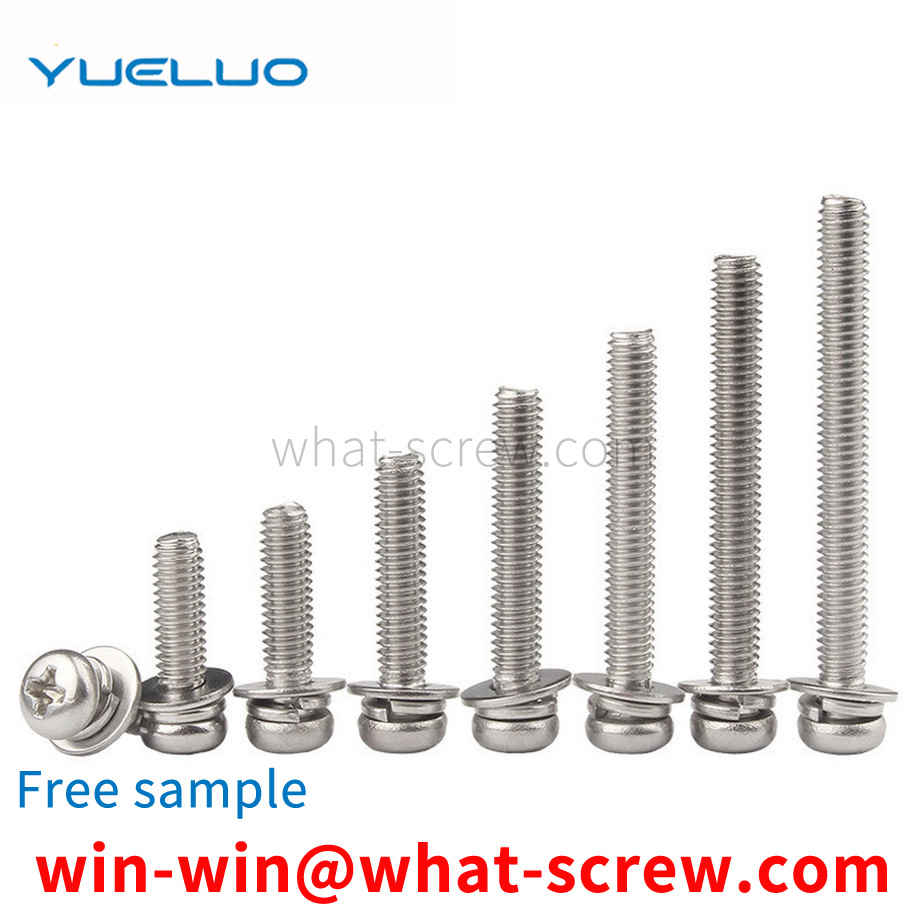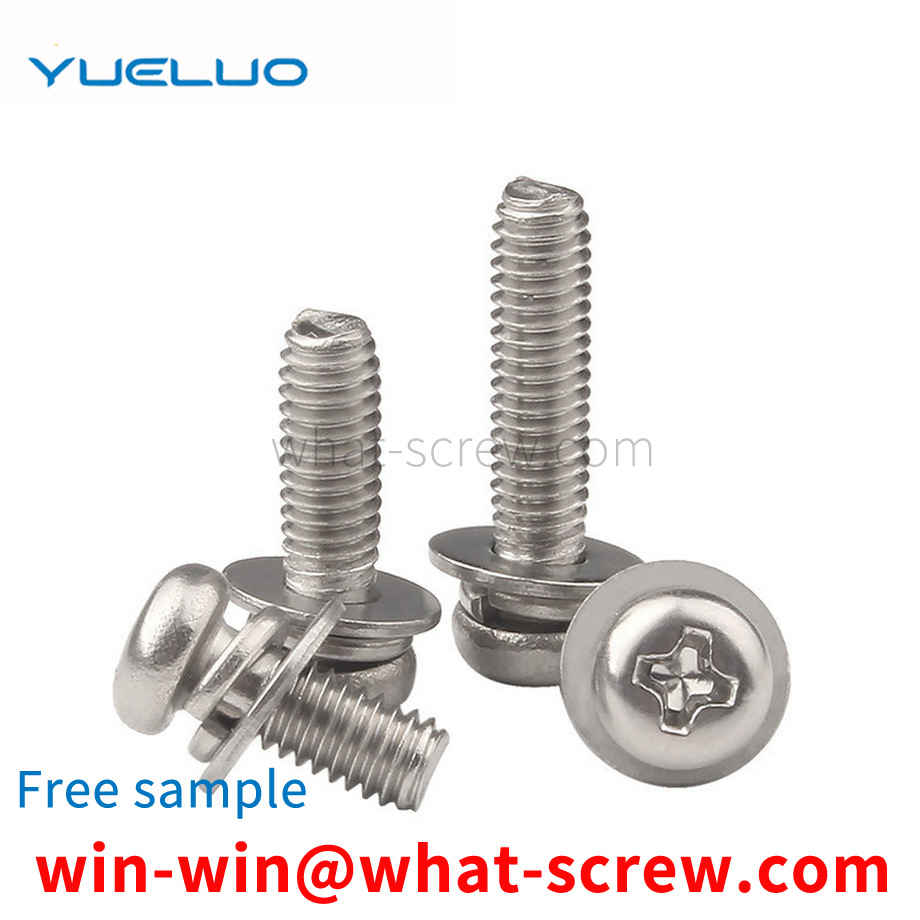A screw can be equipped with only one spring washer or only one flat washer, or it can also only be equipped with a two-piece combination of flower teeth. The national standard number of the combination screw is represented by GB9074. The commonly used cross recessed small pan head three combination screw national standard is GB9074.8. This .8 refers to the small pan head. That is, the size of the head of the pan head screw that is often said. Denoted by letters as PM. Professional combination screw manufacturers, the habitual expression method is three-in-one PM. The commonly used cross recessed large pan head combination screw national standard is GB9074.4. Professionally called large pan head combination screws. Or R head, or B head. That is to say, the head of this combination screw is larger and thicker than the head of the small pan head combination screw. There is also a commonly used external hexagon combination screw, which is a cross external hexagon combination screw. It is often called a socket hexagon combination screw. The national label is GB9074.13.
flat washer, an annular groove is formed on the outer side of the upper surface of the flat washer, and a sealing ring is embedded in the annular groove, at least five circularly equidistantly arranged cylinders are fixed on the upper surface of the flat washer, and the The upper surface of the flat washer is provided with a circular hole that communicates with its bottom, a collar is arranged in the circular hole, an upper circular ring is fixed above the collar, a lower circular ring is fixed below the collar, and the upper circular The diameter of the ring is the same as the diameter of the lower ring, the diameter of the collar is smaller than the diameter of the upper ring, the diameter of the collar is consistent with the diameter of the circular hole, and there are at least three equally spaced holes in the middle of the outer wall of the flat washer. A circular groove, the outer wall of the flat washer is fixed with at least three reinforcing blocks staggered with the circular groove, and the reinforcing blocks and the flat washer are welded into one piece.
Screws are commonly found in machinery, electrical appliances and buildings. They are generally made of metal or plastic, cylindrical in shape, and grooves engraved on the surface are called screw threads. The main function of the screw is to join two objects, or to fix the position of an object. Screws can often be removed or re-tightened at will without compromising their efficiency. Generally, the diameter of the top of the screw is larger, and the common ones are round, square or regular hexagon. If the top is regular hexagon, you can turn the screw with a wrench. If the top is round, there will also be grooves on the front of the top, which is convenient for use screwdriver to turn the screw. *The common grooves are one-shaped, cross-shaped and square, and there are other shapes. The grooves of the existing screws are often easy to wear, which makes the screws inconvenient to use and causes the screws to be scrapped. In addition, because the screws have no chip removal The structure makes it difficult for the screw to penetrate other objects, which affects the efficiency of the screw.
Due to manufacturing and installation errors, the lamp head and its connecting part of the shadowless lamp will drift, which cannot be positioned at any position. Therefore, in the shadowless lamp, the damping force is usually provided by the damping screw to realize the positioning of the lamp cap and its connecting part. The damping screw needs to be able to provide a suitable damping force. The damping force should not be too small to meet the positioning requirements; at the same time, the damping force should not be too large to make the user feel comfortable when moving the lamp head and its connecting parts. In addition, within the normal life range, after the damping screw is worn, it should also be able to provide sufficient damping force to satisfy the positioning of the lamp cap and its connecting part. The damping screw is tightened by the thread, the top pressure disc spring is deformed, and the disc spring presses the friction end to generate frictional force, thereby providing an effective and lasting damping force. The damping force can be realized by adjusting the screw tightness. For the friction ends, there are certain requirements for wear resistance, certain self-lubrication, certain strength, hardness and toughness. At present, the friction end materials in the industry mainly include metals such as brass and tin bronze; non-metals such as nylon and POM. At present, the main disadvantage of the friction end of the damping screw is that it is easy to produce abnormal noise during the friction process for metal materials. For non-metallic materials, deformation is easy to occur and the strength is insufficient.
An anti-falling nut, comprising a lock buckle 1, a lock plate 2, a nut body 3, a lock ring 4 and a lock claw 5, the lock ring 4 and the nut body 3 are used together, the lock ring 4 is a circular ring, and the lock ring 4 is a ring. The inner diameter of the ring 4 is larger than the inner diameter of the circumscribed circle of the nut body 3, the outer diameter of the lock ring 4 is smaller than the inner diameter of the lock 1, the lock plate 2 is an arc-shaped metal plate, and the number of the lock plates 2 is greater than or equal to three. One end of the short side is connected to the nut body 3, the other end of the lock plate 2 is connected to the lock pawl 5, the lock plate 2 is inclined to the outside of the nut body 3, and the lock buckle 1 is provided at the connection end of the lock pawl 5 and the lock plate 2. The outer side of the lock buckle 1 is a concave arc.
We have many years of experience in the production and sales of screws, nuts, flat washers, etc. The main products are: 201 non-standard fastener connectors, Q441 rivets, stud bolts, double-way round copper posts and other products, we can provide you with suitable products Your fastener solution.



















 Service Hotline
Service Hotline




